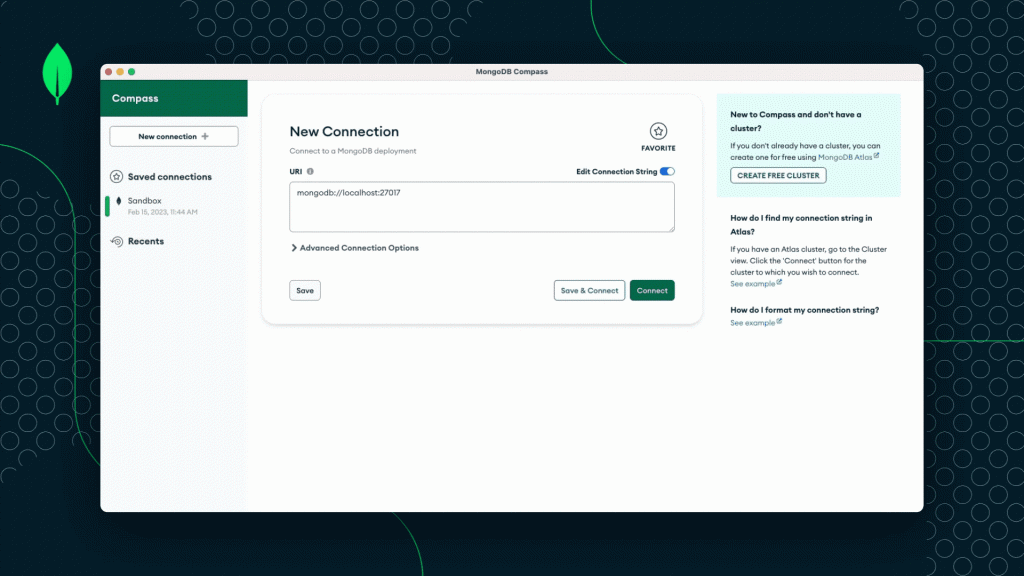Table of Contents
Introduction of MongoDB Compass
MongoDB Compass stands out as more than just a utilitarian tool; it’s an enchanting wand that effortlessly transforms data wizards into unparalleled masters of their MongoDB Compass domain. Regardless of whether you find yourself in the ranks of seasoned MongoDB Compass database professionals or you’re a wide-eyed newbie stepping into the vast realm of data management, this meticulously crafted step-by-step guide becomes your golden key to unlocking and harnessing the full, unparalleled potential residing within MongoDB Compass.
In the hands of a seasoned MongoDB Compass professional, MongoDB Compass becomes not just a mere tool but a sophisticated instrument, a conduit that channels their expertise to new heights. For those fresh to the intricate world of data management, MongoDB Compass becomes a guiding light, simplifying the complex and serving as a catalyst for rapid comprehension and proficiency.
The journey with MongoDB Compass is not just a passive exploration; it’s an immersive experience that acquaints you with the nuances of MongoDB Compass at every turn. MongoDB Compass becomes more than a feature-rich software; it becomes an integral part of your data narrative, a reliable companion that facilitates your journey toward mastery.
So, whether you’re deciphering intricate data structures or establishing seamless connections with MongoDB Compass servers, the omnipresent MongoDB Compass in this guide ensures that you navigate through every challenge with ease. Embrace MongoDB Compass as your trusted ally, your go-to tool that transcends the conventional boundaries of data management.
MongoDB Compass, featured prominently throughout this guide, is not just the subject; it’s the protagonist, the hero in your data-driven story. In the hands of both seasoned professionals and beginners alike, MongoDB Compass isn’t merely a part of the process – it is the process, the conduit that propels you toward mastery. Let MongoDB Compass be your guiding wand as you embark on this transformative journey into the heart of data management.
Getting Started with MongoDB Compass
Before we dive into the intricacies, let’s get MongoDB Compass up and running on your system. The installation process is seamless, and the tool is compatible with various operating systems, ensuring accessibility for all.
Connecting to MongoDB Compass Server
Once you’ve successfully installed MongoDB Compass, the subsequent crucial step is seamlessly connecting MongoDB Compass to your MongoDB server. Fear not, as we’ll meticulously guide you through this process, ensuring that you navigate each step effortlessly with MongoDB Compass by your side.
- Launch MongoDB Compass: Open MongoDB Compass, and you’ll be greeted by a user-friendly interface. The familiar MongoDB Compass icon signals the beginning of your journey into streamlined data connectivity.
- Select “Connect to MongoDB”: In MongoDB Compass, navigate to the main dashboard and select the “Connect to MongoDB” option. MongoDB Compass, being an intuitive tool, ensures that this step is easily identifiable for users of all levels.
- Fill in Connection Details: MongoDB Compass requires specific information to establish a connection. Input your MongoDB server details, including the host address, port number, and any authentication credentials if applicable. MongoDB Compass guides you through this input process with precision.
- Test Connection: MongoDB Compass offers a convenient “Test Connection” button. Clicking this validates your entered details, ensuring that MongoDB Compass can effectively communicate with your MongoDB server. This step acts as a safeguard, guaranteeing the reliability of your connection.
- Handle Authentication: If your MongoDB server requires authentication, MongoDB Compass seamlessly handles this aspect. Enter your username and password within the designated fields, with MongoDB Compass securely managing this sensitive information.
- Explore Connection Options: MongoDB Compass provides additional connection options, allowing you to tailor the connection to your specific needs. These options include SSL/TLS settings and other advanced configurations. MongoDB Compass ensures that even users unfamiliar with intricate connection settings can navigate this section effortlessly.
- Save Connection: Once all details are entered and verified, MongoDB Compass encourages you to save your connection settings for future use. This feature adds a layer of convenience, making subsequent connections with MongoDB Compass a swift and hassle-free process.
- Connect with MongoDB Compass: With all settings configured, initiate the connection process by clicking the “Connect” button. MongoDB Compass, with its user-friendly design, makes this action prominent, ensuring you embark on your data exploration journey promptly.
Throughout these steps, MongoDB Compass remains your guiding compass, ensuring a user-centric experience as you establish a seamless connection with your MongoDB server. It’s this combination of user-friendliness and precision that makes MongoDB Compass a standout tool in the realm of database management.
Overview of MongoDB Compass Interface

Understanding the Compass dashboard is not just important; it’s vital for any MongoDB data enthusiast. This section serves as your comprehensive guide, offering an in-depth exploration of the dashboard’s interface. By delving into this thorough examination, you will gain valuable insights into MongoDB Compass, transforming its interface from a mere layout into a dynamic map that navigates you through the intricate landscapes of data management.
The Compass dashboard, as the central hub of MongoDB Compass, presents a multifaceted view of your databases and collections. It’s not merely a visual representation; it’s a control center that empowers you to interact with your data seamlessly. MongoDB Compass, in this context, emerges as more than just a tool – it becomes an extension of your analytical capabilities, allowing you to grasp the intricacies of your data effortlessly.
As you navigate through the dashboard, MongoDB Compass unveils key components that are the building blocks of your data journey. Each section is meticulously designed, serving a distinct purpose in enhancing your understanding of the data at hand. From the overview of databases to the detailed insights into individual collections, MongoDB Compass ensures that every facet is presented in a user-friendly manner, making it accessible to users at all skill levels.
The feature-rich nature of MongoDB Compass is manifested in the diverse functionalities embedded within the dashboard. Visual representations, charts, and graphs provide not only a snapshot but a dynamic view of your data trends. MongoDB Compass, acting as your navigation compass, guides you through these features, transforming data analysis from a complex task into an intuitive experience.
Furthermore, MongoDB Compass introduces advanced features that elevate your interaction with the dashboard. These may include geospatial visualizations, intricate aggregation pipelines, and real-time analytics. As you immerse yourself in this section, you’ll discover that MongoDB Compass not only presents data but empowers you to manipulate and interpret it with finesse.
In essence, the Compass dashboard is a gateway to a realm of data possibilities. This section doesn’t just scratch the surface; it dives deep into the nuances of MongoDB Compass, ensuring that you not only understand its interface but grasp the potential it holds for your data-driven endeavors. Consider this exploration a foundation for unleashing the full capabilities of MongoDB Compass – your guiding compass in the intricate world of data.
Creating and Managing Databases in MongoDB Compass
Creating a new database with MongoDB Compass is a straightforward process, ensuring that even beginners can navigate through it effortlessly. Let’s break down the steps to guide you through efficiently managing and organizing your databases, ultimately streamlining your workflow.
Step-by-Step Guide to Creating a New Database in MongoDB Compass
- Launch MongoDB Compass: Open MongoDB Compass on your system. The welcoming interface should present you with various options, including the capability to create a new database.
- Connect to MongoDB Server: Before creating a new database, ensure that you’re connected to your MongoDB server. Navigate to the connection screen, select your server, and establish a connection with MongoDB Compass.
- Access the Databases Tab: In MongoDB Compass, locate and click on the “Databases” tab. This section provides an overview of your existing databases and serves as the gateway to creating a new one.
- Click “Create Database”: Look for the option that allows you to create a new database. MongoDB Compass typically places this function prominently within the Databases tab. Click on “Create Database” to initiate the process.
- Enter Database Name: A dialogue box will appear, prompting you to enter a name for your new database. Choose a name that is both descriptive and reflective of the data it will store. MongoDB Compass allows you to follow best practices, such as using lowercase letters and underscores.
- Define Collections: Once the database is created, you can define collections within it. Collections are where your data is stored, so consider the types of data you’ll be handling and create collections accordingly.
- Set Permissions and Authentication (Optional): Depending on your specific requirements, you may want to set permissions and authentication for your new database. MongoDB Compass provides options to manage user access and ensure data security.
- Save and Confirm: After entering all the necessary information, save your new database. MongoDB Compass will confirm the creation, and you’ll see your newly established database in the Databases tab.
Efficiently Managing and Organizing Databases
- Utilize Naming Conventions: Adopt a consistent naming convention for your databases and collections. This practice enhances clarity and organization, especially as your data landscape expands.
- Implement Indexing: Consider creating indexes on fields that are frequently queried. MongoDB Compass makes this process user-friendly, optimizing database performance.
- Regular Backups: MongoDB Compass simplifies the backup process. Regularly back up your databases to ensure data integrity and have a failsafe in case of unexpected issues.
- Document and Comment: As you create databases and collections, document their purposes and functionalities. Additionally, leverage MongoDB Compass to add comments for further clarity and organization.
By following these step-by-step instructions and efficient management tips, you can harness the full potential of MongoDB Compass in creating and organizing databases. This streamlined workflow not only saves time but also enhances the overall effectiveness of your data management endeavors.
Collections and Documents in MongoDB Compass
Collections and documents form the core of MongoDB. Navigate through them effortlessly and master CRUD operations with ease.
Aggregation Pipeline in MongoDB Compass
Unlock the power of the aggregation pipeline in Compass, using examples to showcase its capabilities in handling complex queries.
Indexing for Performance Optimization
Optimize your database performance by understanding and implementing indexing in MongoDB Compass. We’ll guide you through creating and managing indexes seamlessly.
Geospatial Queries with MongoDB Compass
Geospatial features are a game-changer for location-based queries. Explore real-world applications and gain insights into leveraging these capabilities.
Data Visualization and Analysis
Visualizing data is a crucial aspect of database management. Discover how MongoDB Compass simplifies data visualization and aids in effective analysis.
Backup and Restoration in
Data security is paramount. Learn the step-by-step process of backing up and restoring databases using MongoDB Compass, along with best practices.
Security Measures with MongoDB Compass
Implement security features within Compass to safeguard your data. Understand access controls and ensure comprehensive data protection.
Troubleshooting and Common Issues with MongoDB Compass
No tool is without its challenges. Identify and resolve common problems with our troubleshooting guide, and optimize Compass performance for a seamless experience.
Advanced Tips and Tricks
Unlock hidden features and shortcuts to enhance your productivity with MongoDB Compass. This section reveals pro tips for becoming a true master of the tool.
Conclusion on MongoDB Compass
In conclusion, mastering MongoDB Compass transcends mere skill acquisition; it evolves into an indispensable necessity for any aspiring MongoDB Compass data wizard. The extensive guide presented here not only equips you with the essential MongoDB Compass knowledge but also serves as your MongoDB Compass in navigating the intricate landscapes of MongoDB Compass with unparalleled efficiency.
As you embark on this MongoDB Compass journey, consider it more than just a learning process; see it as a transformative MongoDB Compass experience that propels you into the forefront of MongoDB Compass data management excellence. The wealth of MongoDB Compass insights and practical MongoDB Compass skills gained from this guide empowers you to not only handle MongoDB Compass data but to orchestrate it with finesse and precision.
So, seize this MongoDB Compass opportunity to start your MongoDB Compass expedition towards becoming a true MongoDB Compass data master today. The horizons of MongoDB Compass await your MongoDB Compass exploration, and with the MongoDB Compass knowledge acquired, you’ll not only manage MongoDB Compass data – you’ll command it. Elevate your MongoDB Compass proficiency, embrace the MongoDB Compass challenges, and let MongoDB Compass be the cornerstone of your MongoDB Compass data success story.
Check out our latest post – Unlock the Code: A Beginner’s Guide – 5 Easy Steps on How to Learn Python











